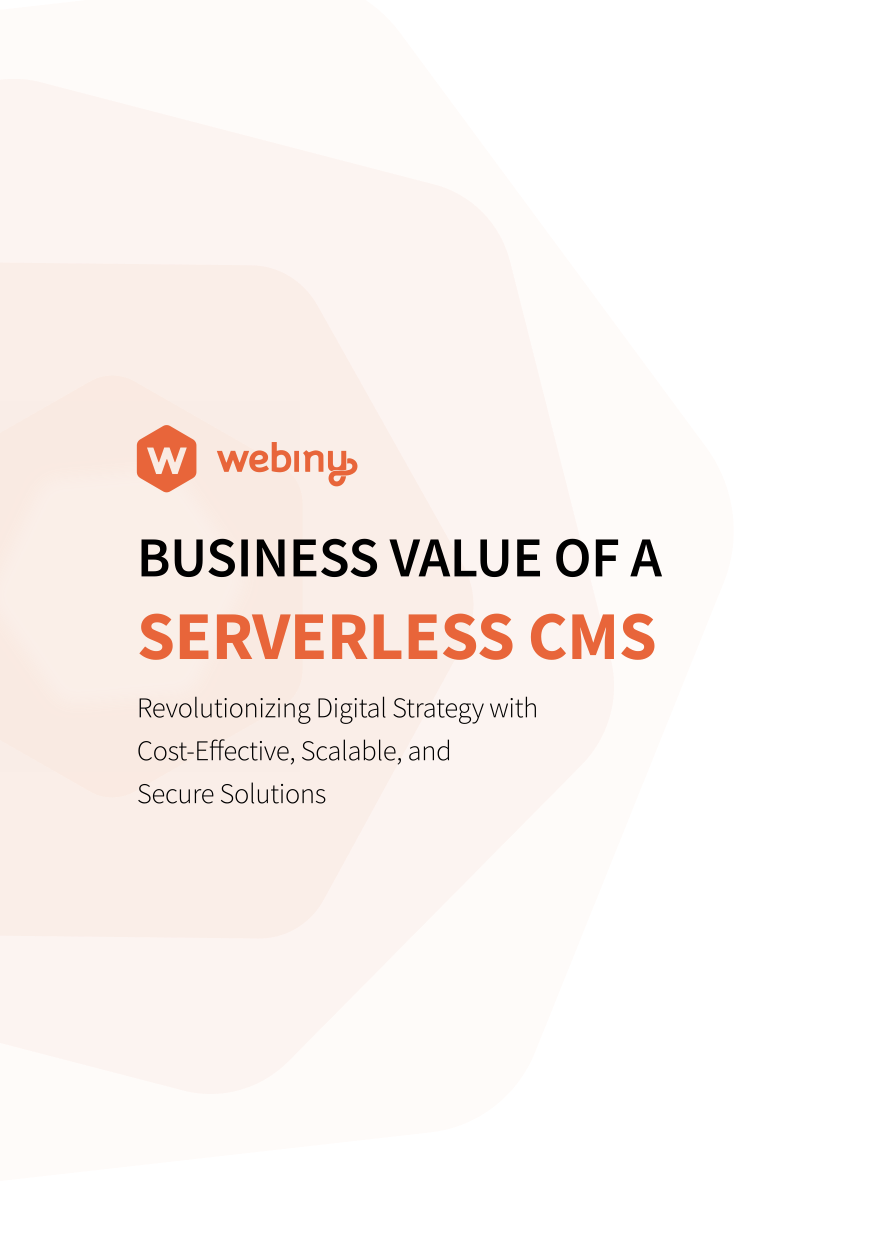BOOK A CALL
Composable open-source content platform that shapes around your business
Host within your AWS account on top of serverless infrastructure and bring your own AI models.
Increase the reliability, performance and security of your content platform under enterprise workloads, and reduce your infrastructure spend.
RECOGNIZED BY GARTNER DIGITAL MARKETS


Webiny is the choice of leaders
World’s leading companies use Webiny to create, manage and deliver content at scale while keeping privacy at the forefront.
siemens.com
Siemens chose Webiny to power their global website.
Customization & Data ownership
Main reasons why Siemens went with Webiny.

Siemens chose Webiny as their new home for siemens.com.
While evaluating all the options on the market, and also the potential of a DIY approach, Webiny stood out as the best platform when it came to meeting Siemens' demands in terms of customization, scale, performance and feature set.
Siemens decided Webiny was the best platform to power siemens.com, 300 regional offices, across 60 languages and with over 1200 content writers creating content.
90M data points
Size of the data set that was migrated to Webiny.
Collaboration & Support
The most praised thing about working with Webiny.
Products used


Motortrend.com the largest automotive media platform in the world
Motortrend, a Warner Bros. Discovery (WBD) brand, chose Webiny as their content platform as it was the only one on the market that met the high bar of scale and customization.
Global project
Webiny as a foundation for a multi-region, multi-language project.
Ideal architecture
Serverless and open-source made Webiny an easy choice.
Products used

"If we were to build our own CMS, we would build it like Webiny." - Sr. Eng. Manager at AWS
AWS was in the process or rebuilding one of their global product offerings for which they needed a highly-scalable and very customizable platform to use as a foundation in order to deliver the project on budget and in time. Webiny stood out from the crowd due to it's unique offering and serverless infrastructure.
Infinite scalability
Delivering scalable and uninterrupted service during peak usage.
Personalised experience
Ability to tailor the loyalty program experience to an individual customer.
Products used

Starbucks chose Webiny to power their loyalty app
Starbucks, a global coffeehouse leader, recently revolutionized its loyalty program mobile application by integrating Webiny as the backend solution. This strategic move aimed to enhance customer experiences through serverless infrastructure and unparalleled customization options.
More than a CMS - 5+ products in one
It’s a no-code suite of products helping you create, manage
and distribute both content and assets
The most scalable and customizable self-hosted Headless CMS on the market
Use Webiny Headless CMS when you need:
- Unprecedented scale
- Control and customization
- Full data ownership and governance
- Deep integrations with existing systems
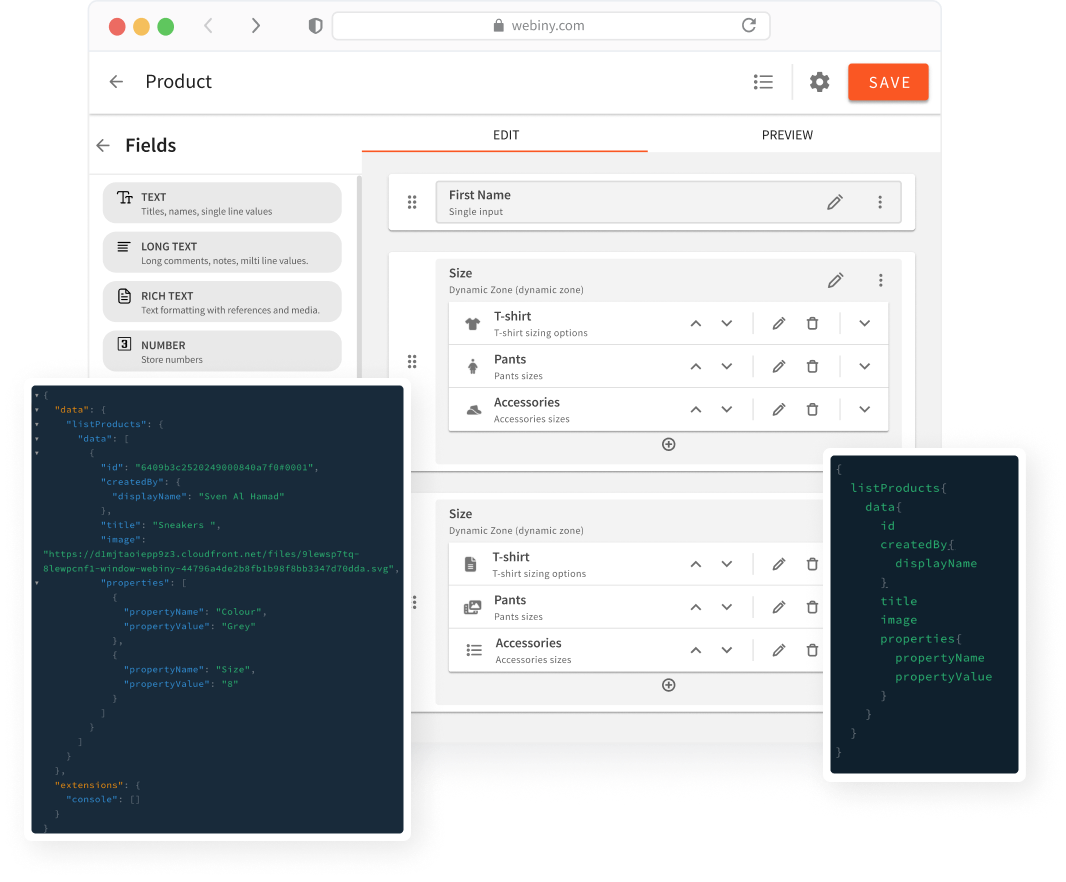
Enterprise-ready no-code Page Builder
Use Webiny Page Builder when you need to:
- Build stunning landing pages in seconds
- Build dynamic pages, such as product pages, blogs, training courses and more
- Bring your own custom interactive components
- Provide your content creators with a library of ready-made templates and building blocks
- Deliver pages at scale to large audiences
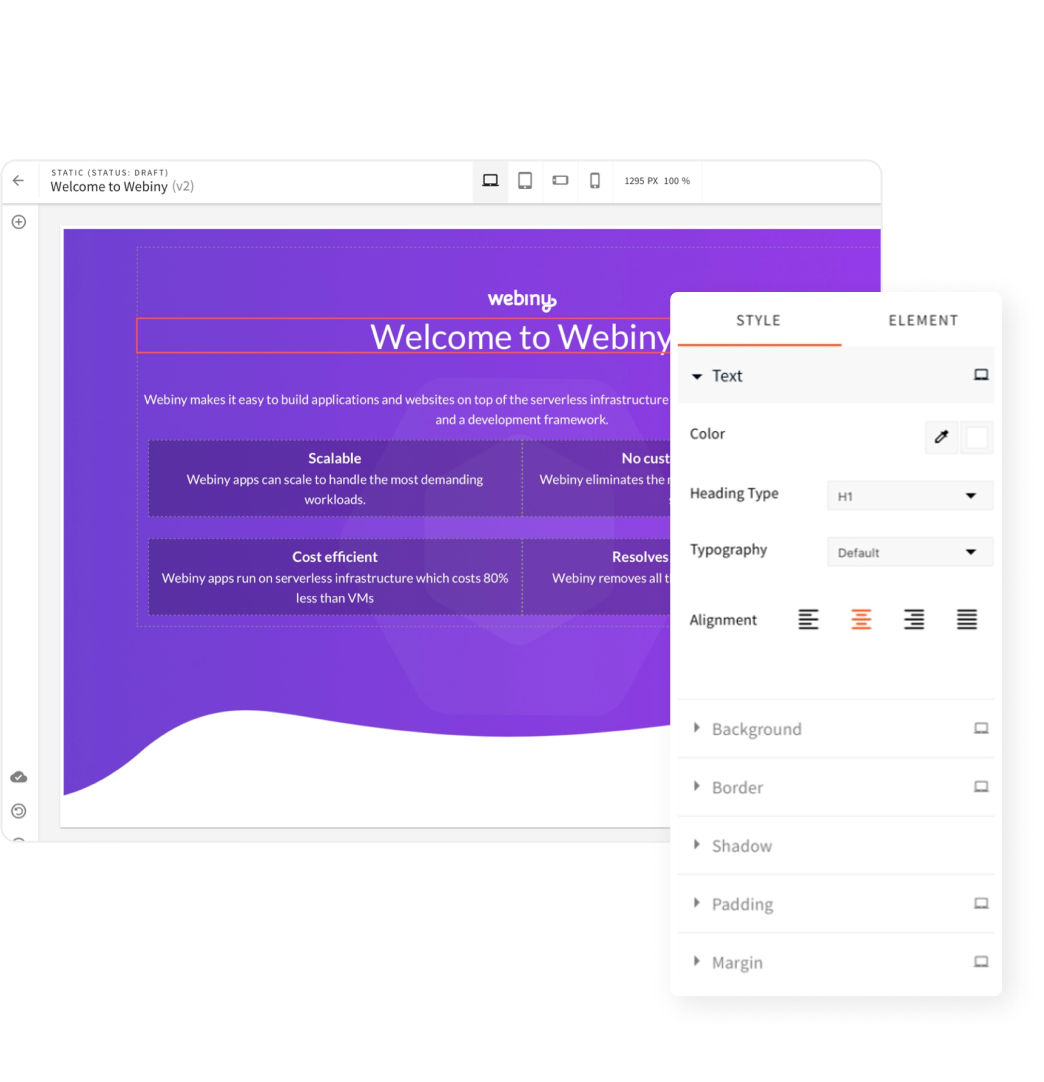
Highly scalable digital asset manager built on top-of serverless technology
Use Webiny File Manager when you need to:
- Store and organize large amounts of digital assets
- Embed and share digital assets inside Webiny CMS
- Store assets securely within your own AWS account and geo
- Manage assets programatically through a GraphQL API
- Deliver assets efficiently and at scale
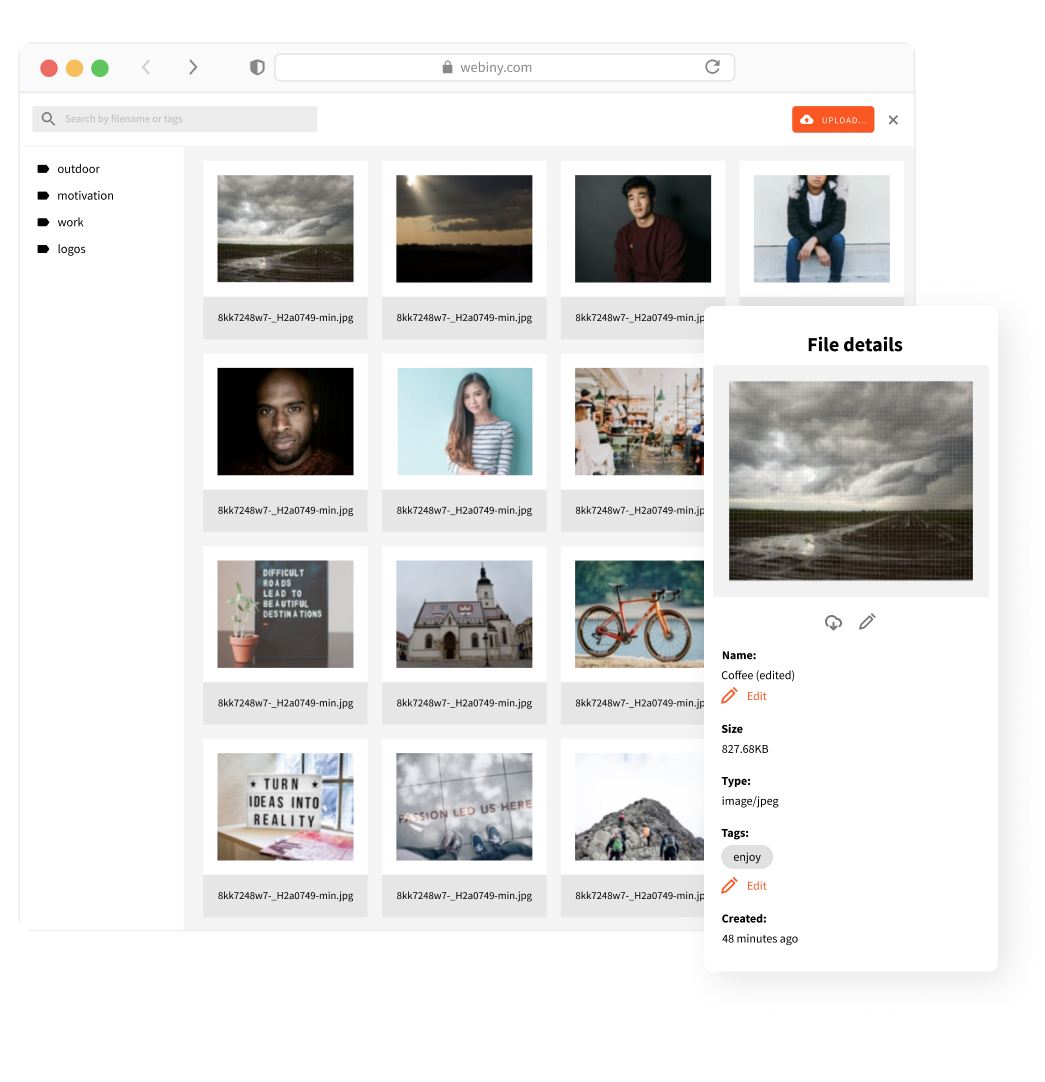
Multi-Step Collaborative publishing review process
Use Webiny Advanced Publishing Workflow when you need to:
- Ensure only reviewed and approved content gets published
- Reduce the risk of mistakes and errors within your content
- Reduce the risk of potential damage to your brand reputation
- Have an established review process across your digital presence
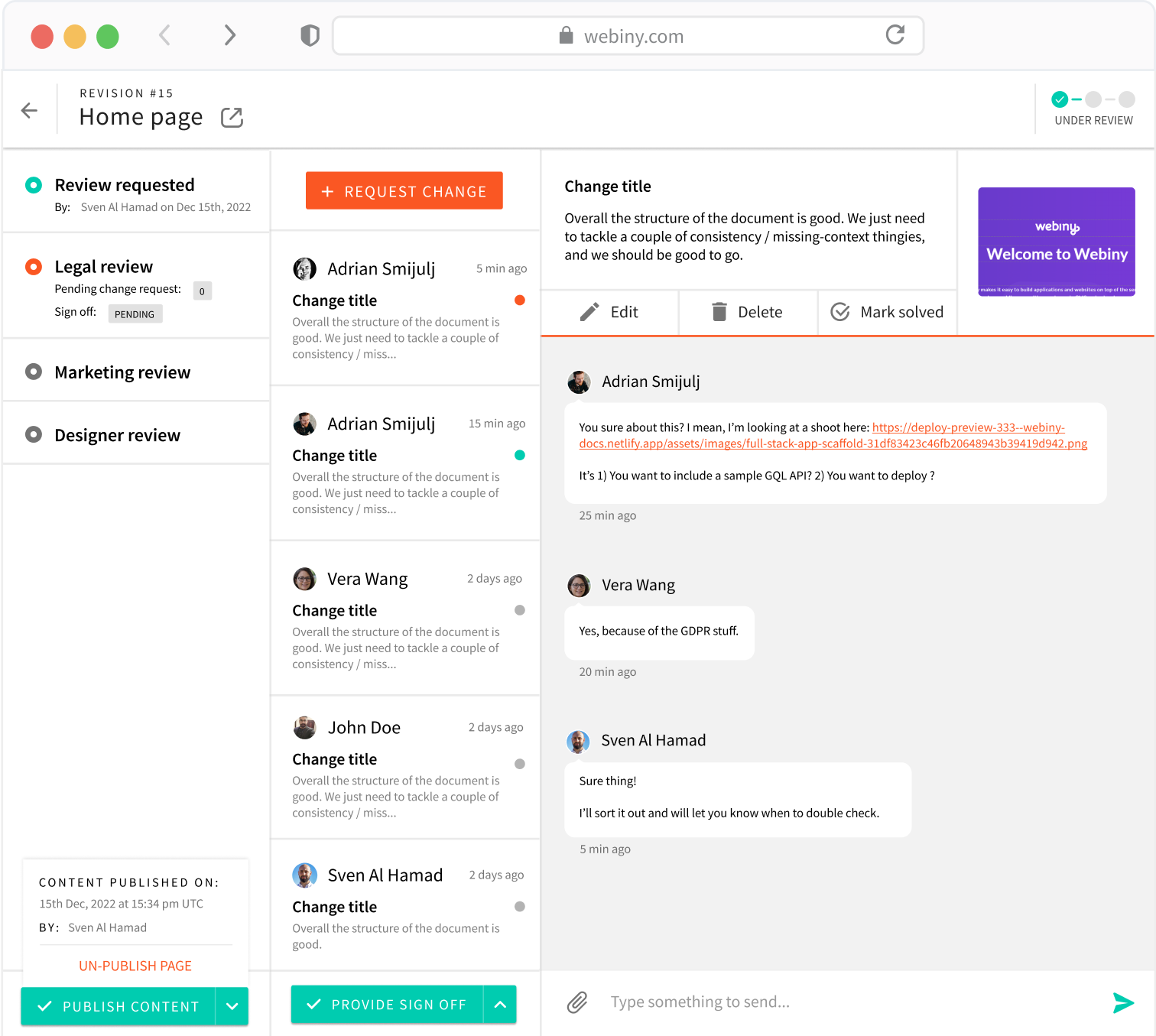
No-code solution for your marketing teams to build forms and capture leads
Use Webiny Form Builder when you need to:
- Empower marketing teams to autonomously create lead-gen forms
- Easily insert forms to your Page Builder pages
- Create workflows and integrate with tools like Zapier
- Connect your forms to 3rd party systems and APIs
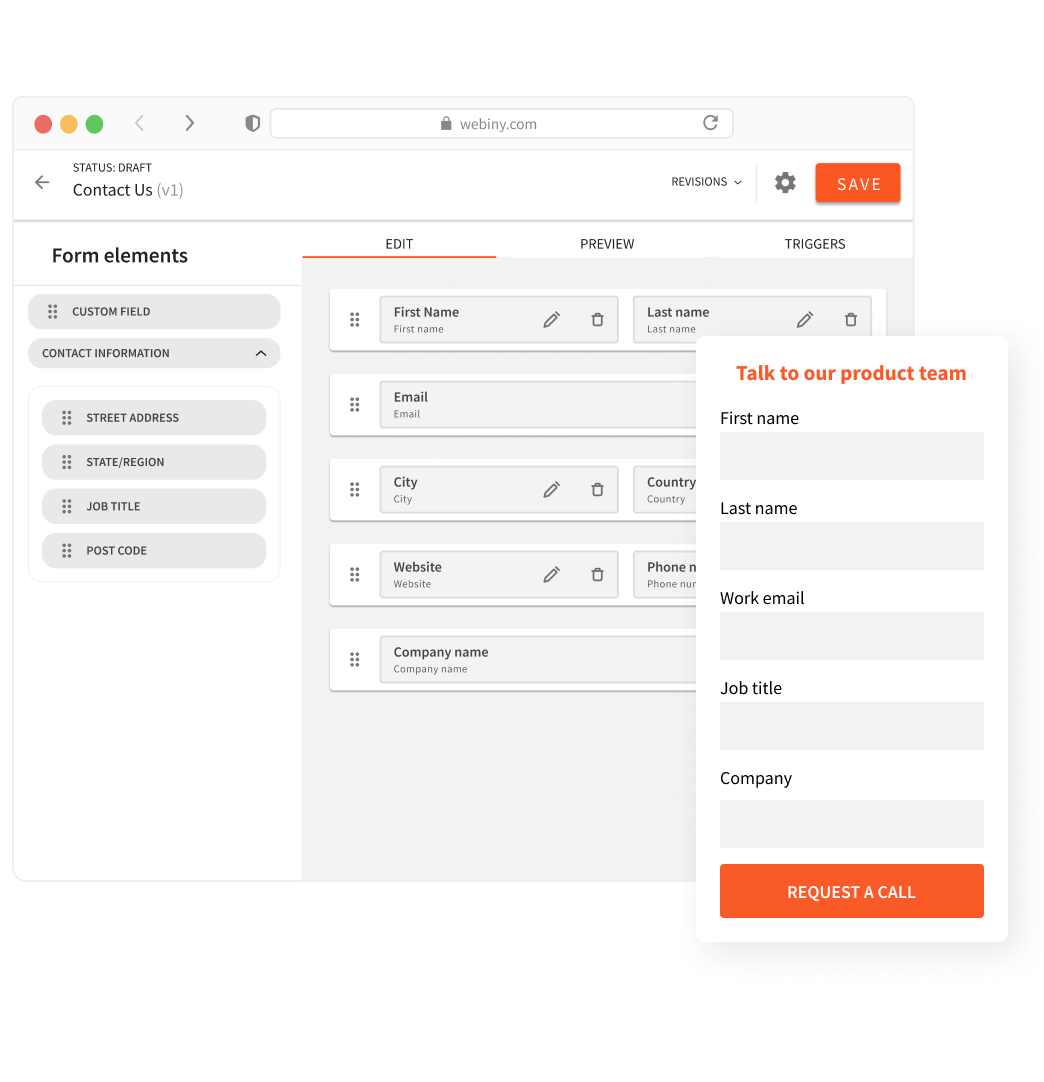
Explore real-world examples of business transformation with Webiny.
Learn why these companies made the switch and the results they achieved.
When DIY is too labour intensive, and SaaS is too limiting
We take a different approach to the rest of the market. We cut the cost of the DIY approach, whilst allowing the customizability beyond what any SaaS solution can provide, all whilst keeping you in control of your data.

Webiny Composable Content Platform
A fully customizable end-to-end solution designed with performance, reliability and security in mind,
for your most complex and critical projects. With Webiny you are not limited to the experiences the system allows
you to create, but only by your imagination.
When DIY is too labour intensive, and SaaS is too limiting
We take a different approach to the rest of the market. We cut the cost of the DIY approach, whilst allowing the customizability beyond what any SaaS solution can provide, all whilst keeping you in control of your data.
ARTIFICIAL INTELIGENCE
AI model-agnostic platform
Integrate with different models and craft tailored AI-experiences. You control which model and what
AI-powered capabilities your users and content editors can use.
PICK ANY MODEL YOU WANT,
OR BRING YOUR OWN
INTEGRATE WITH WEBINY THROUGH THE API,
LIFECYCLE EVENTS AND PLUGINS
AUTOMATE ACTIONS AND BUILD
NEW EXPERIENCES
Choice of models
Integrate with any of the different models available on the market. Have an in-house custom trained model, or need to use a specialized model? Those work great too!
Compliance & regulation
Given the rapidly changing landscape around AI regulations, with Webiny you can quickly react to upcoming changes and use models that are approved and compliant with your business.
Different use-cases
Every company has a different approach to AI. Some want to automate a lot, others prefer to leave only the mundane stuff to AI. With Webiny you are in control and you define what AI capabilities will be available to your users.
Training data source
Storing your data inside Webiny makes it easily accessible through the GraphQL API. This is useful as Webiny can act as a data source in cases when you want to use that data to train your own custom LLM.
The foundation behind Webiny
The end-to-end platform that Webiny provides solves challenges around data ownership, customizations,
infrastructure cost, scalability & reliability and helps you manage the full content lifecycle.
Lorem ipsum dolor sit amet, consectetur adipiscing elit. Cras iaculis et libero eget
eleifend. Vestibulum felis ipsum, aliquet eget semper at, eleifend non nisl.
Multi-tenancy
Host thousands of projects from a single instance
Open source
Architected to be extended and customized.
Self-hosted
Your data under your terms. A privacy-focused CMS.
AWS Serverless Infrastructure
Webiny runs on highly-scalable fault-tolerant serverless services.
Development framework
Build new features, change existing ones, or create whole new apps.
CMS+
No-code suite of solutions helping you create, manage and distribute content.
It’s a platform your engineering team will love using
Lorem ipsum dolor sit amet, consectetur adipiscing elit. Cras iaculis et libero eget eleifend. Vestibulum felis ipsum, aliquet eget semper at, eleifend non nisl.
Typescript support
Type definitions across the whole project to help you get around.
Deploy to multiple environments
Using Webiny CLI you can propagate code trough different environments, like dev, prod.
Extendable GraphQL API
Change existing GraphQL resolvers, or add new ones in a few lines of code.
SOC2 compliant setup
Webiny is deployed inside your AWS account following all security best practices.
Bring your own IdP
You can integrate any of your existing IdPs.
Pulumi IaC
Control and modify your infrastructure through Pulumi IaC.
70+
Contributors
2,700+
Developers on Slack
7,200+
GitHub stars
When we say customizable & extendable, we really mean it!
Webiny is architected from the ground up to be adopted, extended and built upon. You can literally change every part of Webiny, in a safe and maintainable way.
Trigger custom functions
Lifecycle events are added on top of folder actions which can be used to trigger custom functions.
12new ContextPlugin<AcoContext>(async context => {3 context.aco.onFolderAfterCreate.subscribe(async ({ folder }) => {4 // Trigger custom function here5 console.log('Folder created', folder.title);6 });7});8
Register a custom bulk action
When selecting multiple entries, you can register custom bulk actions that the user can perform.
12<ContentEntryListConfig>3 <BulkAction4 name={"copy-json"}5 element={<ActionCopyJson />}6 modelIds={["article"]}7 />8</ContentEntryListConfig>9
Register a custom filter
You can register custom filters to filter the entries in the list.
12<ContentEntryListConfig>3 <Browser.Filter name={"demo-filter"} element={<span>Demo Filter</span>} />4</ContentEntryListConfig>5
Show/hide columns
Configure on a per-model basis which columns are shown in the list view.
12<ContentEntryListConfig>3 <Browser.Column4 name={"price"}5 header={"Price"}6 modelIds={["property"]}7 />8</ContentEntryListConfig>9
Custom column renderer
Control how a column is rendered in the list view.
12export const CellPrice = () => {3 // You can destructure child methods to make the code more readable and easier to work with.4 const { useTableRow, isFolderRow } = ContentEntryListConfig.Browser.Table.Column;5 // useTableRow() allows you to access the entire data of the current row.6 const { row } = useTableRow();78 // isFolderRow() allows for custom rendering when the current row is a folder.9 if (isFolderRow(row)) {10 return <>{"-"}</>;11 }1213 const currency = new Intl.NumberFormat("en-US", {14 style: "currency",15 currency: row.currency // Let's use the currency defined in the entry.16 });1718 // Let's render the entry price.19 return <>{currency.format(row.price)}</>;20};21<ContentEntryListConfig>22 <Browser.Column23 name={"price"}24 header={"Price"}25 modelIds={["property"]}26 cell={<CellPrice />}27 />28</ContentEntryListConfig>29
Customize search query
Customize how search query works and how the input parameters are handled.
12export const CellPrice = () => {3 // You can destructure child methods to make the code more readable and easier to work with.4 const { useTableRow, isFolderRow } = ContentEntryListConfig.Browser.Table.Column;5 // useTableRow() allows you to access the entire data of the current row.6 const { row } = useTableRow();78 // isFolderRow() allows for custom rendering when the current row is a folder.9 if (isFolderRow(row)) {10 return <>{"-"}</>;11 }1213 const currency = new Intl.NumberFormat("en-US", {14 style: "currency",15 currency: row.currency // Let's use the currency defined in the entry.16 });1718 // Let's render the entry price.19 return <>{currency.format(row.price)}</>;20};21<ContentEntryListConfig>22 <Browser.Column23 name={"price"}24 header={"Price"}25 modelIds={["property"]}26 cell={<CellPrice />}27 />28</ContentEntryListConfig>29
Custom action on an entry
Remove or register new actions that can be performed on an entry.
12<ContentEntryListConfig>3 <Browser.EntryAction4 name={"copy-json"}5 element={<CopyEntryData />}6 modelIds={["property"]}7 />8</ContentEntryListConfig>9
Custom element group
Register a custom element group
12export default {3 name: "pb-editor-element-group-webiny-website",4 type: "pb-editor-page-element-group",5 group: {6 title: "Webiny Website",7 icon: <Icon />8 }9} as PbEditorPageElementGroupPlugin;10
Custom element
Register a custom element you can use to build your page
12const plugin = {3 name: "pb-render-page-element-space-x",4 type: "pb-render-page-element",5 elementType: "spaceX",6 render: SpaceX7} as PbRenderElementPlugin;8
Control element nesting
Create advanced nestable elements and control where and how they can be nested
12const plugin = {3 name: "pb-render-page-element-child-example",4 type: "pb-render-page-element",5 elementType: "childExample",6 render: ChildExample,7 // Whitelist elements that can accept this element8 // (for drag&drop interaction)9 target: ["cell", "block"],10} as PbEditorPageElementPlugin;11
Interactive elements
Create elements that are interactive and can also fetch data from external sources
12export const SpaceX = createRenderer(() => {3 // Let's retrieve the variables that were chosen by4 // the user upon dropping the page element onto the page.5 const { getElement } = useRenderer();6 const element = getElement<SpaceXElementData>();7 const { limit, offset, type } = element.data.variables;89 const [data, setData] = useState<Spacecraft[]>([]);1011 // This is where we fetch the data and store it into component's state.12 useEffect(() => {13 request(GQL_API_URL, QUERIES[type], {14 limit: parseInt(limit),15 offset: parseInt(offset)16 }).then(({ data }) => setData(data));17 }, [limit, offset, type]);1819 if (!data.length) {20 return <>Nothing to show.</>;21 }2223 return <>SpaceX has {data.length} rockets</>;24});2526const plugin = {27 name: "pb-render-page-element-space-x",28 type: "pb-render-page-element",29 elementType: "spaceX",30 render: SpaceX31} as PbRenderElementPlugin;32
Style plugins
Register custom plugins to define new style props, or remove existing style props
12export default {3 name: "pb-editor-page-element-style-settings-text",4 type: "pb-editor-page-element-style-settings",5 render({ options }) {6 return <TextSettings options={options} />;7 }8} as PbEditorPageElementStyleSettingsPlugin;9
Element plugins
Register custom attributes for your custom elements. Example, define which category of products will be listed inside your custom listing component.
12export default {3 name: "pb-editor-page-element-advanced-settings-carousel",4 type: "pb-editor-page-element-advanced-settings",5 elementType: "carousel",6 render() {7 return <CarouselItems />;8 }9} as PbEditorPageElementAdvancedSettingsPlugin;10
Extend page settings
Remove page settings props you don't need. Create custom page settings props for your own needs.
12export default [3 // Add 'password' to the page settings types4 new GraphQLSchemaPlugin<Context>({5 typeDefs: /* GraphQL */ `6 extend type PbGeneralPageSettings {7 password: String8 }910 extend input PbGeneralPageSettingsInput {11 password: String12 }13 `14 }),15 // Subscribe to the page update event using the ContextPlugin.16 new ContextPlugin<PbContext>(({ pageBuilder }) => {17 // We are passing a custom event type to allow us to use the new 'password' field.18 pageBuilder.onBeforePageUpdate.subscribe<CustomEventParams>(({ page, input }) => {19 // Explicitly assign the field value from GraphQL input to the data that is used to update the page.20 page.settings.general.password = input.settings.general.password;21 });22 })23 ];24
Lifecycle events
Take over the publish button action and trigger a custom action. Or an action that happens before or and after the page publish event.
12new ContextPlugin<PbContext>(async context => {3 context.pageBuilder.onBeforePagePublish.subscribe(async ({ latestPage, page }) => {4 /**5 * For example, we do not allow a page which is not the latest one to be published.6 */7 if (latestPage.version > page.version) {8 throw new Error(`Page you are trying to publish is not the latest revision of the page.`);9 }10 });11 });12
Custom file type
Register a plugin to add a new file type handler to the file manager
12export default [3 new FileManagerFileTypePlugin({4 types: ["video/mp4"],5 render({ file }) {6 return (7 <div style={{ paddingTop: "40%" }}>8 <strong>My MP4</strong>9 <br />10 <span>{file.name}</span>11 <br />12 <span>{file.size} bytes</span>13 </div>14 );15 }16 })17];18
Custom File Manager UI
Register your own custom File Manager UI, useful if you want to use a different DAM system, something like Cloudinary, Dropbox, etc.
12const CustomFileManager = createDecorator(FileManagerRenderer, () => {3 return function FileManagerRenderer(props) {4 const setRandomImage = () => {5 const id = Date.now().toString();6 const image: FileManagerFileItem = {7 id,8 src: `https://picsum.photos/seed/${id}/200/300`,9 meta: [{ key: "source", value: "https://picsum.photos/" }]10 };11 if (props.multiple) {12 props.onChange && props.onChange([image]);13 } else {14 props.onChange && props.onChange(image);15 }16 props.onClose && props.onClose();17 };1819 return (20 <OverlayLayout onExited={() => props.onClose && props.onClose()}>21 {/* Render a simple button, and assign a random image on click. */}22 <button onClick={setRandomImage}>Set random image</button>23 </OverlayLayout>24 );25 };26 });2728 export const App = () => {29 return (30 <Admin>31 <Cognito />32 {/* Mount the plugin, which will register a HOC for the `FileManagerRenderer`. */}33 <CustomFileManager />34 </Admin>35 );36 };37
Custom file filters
Create a custom filter that can be used to filter files in the File Manager
12const { Browser } = FileManagerViewConfig;34const DemoFilter = () => {5 return <span>Demo Filter</span>;6}78export const App = () => {9 return (10 <Admin>11 <Cognito />12 <FileManagerViewConfig>13 <Browser.Filter name={"new-filter"} element={<DemoFilter />} />14 </FileManagerViewConfig>15 </Admin>16 );17};18
Custom file fields
Add custom meta data fields to your files
12export const handler = createHandler({3 plugins: [4 // Other plugins were omitted for clarity.56 // Add the following code after your existing plugins.7 createFileModelModifier(({ modifier }) => {8 modifier.addField({9 id: "carMake",10 fieldId: "carMake",11 label: "Car Make",12 type: "text",13 renderer: {14 name: "text-input"15 }16 });1718 modifier.addField({19 id: "year",20 fieldId: "year",21 label: "Year of manufacturing",22 type: "number",23 renderer: {24 name: "number-input"25 }26 });27 })28 ],29 http: { debug }30});31
Customize File Details Drawer
Change the UI of the details drawer. You can change the size of the drawer, hide fields, and group fields.
12<FileManagerViewConfig>3 {/* Use percentage value. */}4 <FileDetails.Width value={"80%"} />5 {/* Use pixel value. */}6 <FileDetails.Width value={"1300px"} />7</FileManagerViewConfig>8
File lifecycle events
You can listen to file lifecycle events, such as file upload, file delete, etc. and trigger custom functions.
12new ContextPlugin<FileManagerContext>(async context => {3 context.fileManager.onFileAfterCreate.subscribe(async ({ file }) => {4 // Send a notification to Slack, or any other service.5 await sendNotificationToSlack({6 text: `New file created: ${file.name}`7 });8 });9 });10
Extend the GraphQL API
Extend the GraphQL types and operations
12new CmsGraphQLSchemaPlugin<Context>({3 // Extend the `Query` type with the `listMyPosts` query. Note the `PostListResponse` type.4 // It exists because we've previously created the `Post` content model via Admin Area.5 typeDefs: /* GraphQL */ `6 extend type Query {7 # List posts that were created by the currently logged in user.8 listMyPosts: PostListResponse9 }10 `,11 // In order for the `listMyPosts` to work, we also need to create a resolver function.12 resolvers: {13 Query: {14 listMyPosts: async (_, args: { id: string }, context) => {15 const { security, cms } = context;1617 // Retrieve the `post` model.18 const model = await cms.models.get("post");1920 // Use the `cms.entries.listLatest` method to fetch latest entries for the currently21 // logged in user. Note that you could also use the `listPublished` method here instead22 // of `cms.entries.listLatest`, if a list of published pages is what you need.23 const response: [CmsContentEntry[], CmsContentEntryMeta] = await cms.entries.listLatest(24 model,25 {26 where: {27 // Retrieving the currently logged is as easy as calling the security.getIdentity method.28 createdBy: security.getIdentity().id29 }30 }31 );3233 return new ListResponse(...response);34 }35 }36 }37 })38
Implement custom sorting logic
Create custom sorting for user defined content models
12export const customSorterPlugin = createCmsGraphQLSchemaSorterPlugin(({ sorters, model }) => {3 // we only want to add the sorter when generating a certain model GraphQL Schema4 if (model.modelId !== "yourTargetModelId") {5 return sorters;6 }7 return [...sorters, "myCustomSorting_ASC", "myCustomSorting_DESC"];8});9
Define Headless CMS content models via code
Code-based content models can be used to implement custom business logic and make it easier to version your schema changes
12export default [3 // Defines a new "E-Commerce" content models group.4 new CmsGroupPlugin({5 id: "ecommerce",6 name: "E-Commerce",7 description: "E-Commerce content model group",8 slug: "e-commerce",9 icon: "fas/shopping-cart"10 }),1112 // Defines a new "Product" content model.13 new CmsModelPlugin({14 name: "Product",15 modelId: "product",16 description: "Product content model",17 group: {18 id: "ecommerce",19 name: "E-Commerce"20 },21 fields: [22 {23 id: "productName",24 fieldId: "productName",25 type: "text",26 label: "Product Name",27 helpText: "A short product name",28 renderer: { name: "text-input" },29 validation: [30 {31 name: "required",32 message: "Value is required."33 }34 ]35 },36 {37 id: "productSku",38 fieldId: "productSku",39 type: "text",40 label: "SKU",41 placeholderText: "SKU = Stock Keeping Unit",42 renderer: { name: "text-input" }43 },44 {45 id: "productPrice",46 fieldId: "productPrice",47 type: "number",48 label: "Price",49 renderer: { name: "text-input" }50 }51 ],52 layout: [["productName"], ["productSku", "productPrice"]],53 titleFieldId: "productName"54 })55 ];56
Lifecycle events
Create custom functions that are executed at specific points in the lifecycle of a content entry
12new ContextPlugin<CmsContext>(async context => {3 context.cms.onEntryAfterUpdate.subscribe(async ({ model, entry }) => {4 /**5 * For example, notify another system about updated entry.6 */7 await notifyAnotherSystemAboutEntryUpdate({ model, entry });8 });9});10
Storage transformation
Transform your data before it is stored in the database, and before it is returned to the client
12new StorageTransformPlugin({3 fieldType: "time",4 fromStorage: async ({ value }) => {5 const hours = Math.floor(value / 3600);6 const secondsAfterHours = value - hours * 3600;7 const minutes = secondsAfterHours > 0 ? Math.floor(secondsAfterHours / 60) : 0;8 const seconds = secondsAfterHours - minutes * 60;910 return [hours, minutes, seconds].map(value => String(value).padStart(2, "0")).join(":");11 },12 toStorage: async ({ value }) => {13 const [hours, minutes, seconds] = value.split(":").map(Number);1415 return hours * 3600 + minutes * 60 + seconds;16 }17 });18

Self-hosting Powered by Serverless
The infrastructure you cannot outgrow
Historically self-hosting has been hard, but the times have changed. Serverless infrastructure significantly reduces the operational costs of self-hosting, while giving you an infrastructure setup that's more secure and more scalable than what many off-the-shelf SaaS solutions can provide.
Want more proof? Give us a call, we're happy to show you.
Resilient & Scalable
The underlying serverless infrastructure is fault-tollerant, and can scale to handle workloads from your very first user, to your first million users, and beyond.

Your Data, Your Rules
Webiny is self-hosted, your data is your own, nobody else has access to it.
It’s easy to check-in, but also to check-out. No lock-in!

Cost-Efficient
The consumption-based pricing model of serverless infrastructure ensures you never overpay or overprovision your infrastructure ever again.
Secure Infrastructure
The infrastructure is maintained by the cloud vendor for you. It will save you time and money, and reduce potential attack vectors, while making you more secure.

Data Governance
Webiny being self-hosted means you can apply your own data governance requirements.
Webiny is SOC2 compliant out-of-the-box, but you don't need to stop there, GDPR, FedRAMP and HIPPA compliances can also be met.


Increase Operational Efficiency
Less time spent on infrastructure management unlocks more time spent doing the work that really matterrs, like building better products.

Bring Your Users
Webiny provides integration points to bring any existing IdP or SSO setup, including any custom made ones.

Bring Your VPC
Webiny can be deployed inside an existing VPC. What’s more, this allows Webiny to communicate and tightly integrate with all your current systems and applications in a secure way.

Bring Your Security
We believe any security that's based on "trust" is a bad practice. With most SaaS vendors instead of zero-trust approach, you get the "trust me" approach.
Webiny is the opposite, you own your data and control your security.
Bring and integrate your own Firewall, IDPS and monitoring system.


Ready to get started?
For business teams
Discuss your business/project needs and CMS requirements
Get the answers to your specific business questions
See Webiny in action and learn how it can power your business
For developers
Install Webiny in just 4 minutes.
Learn how to create a new Webiny project and deploy it into your AWS account.
